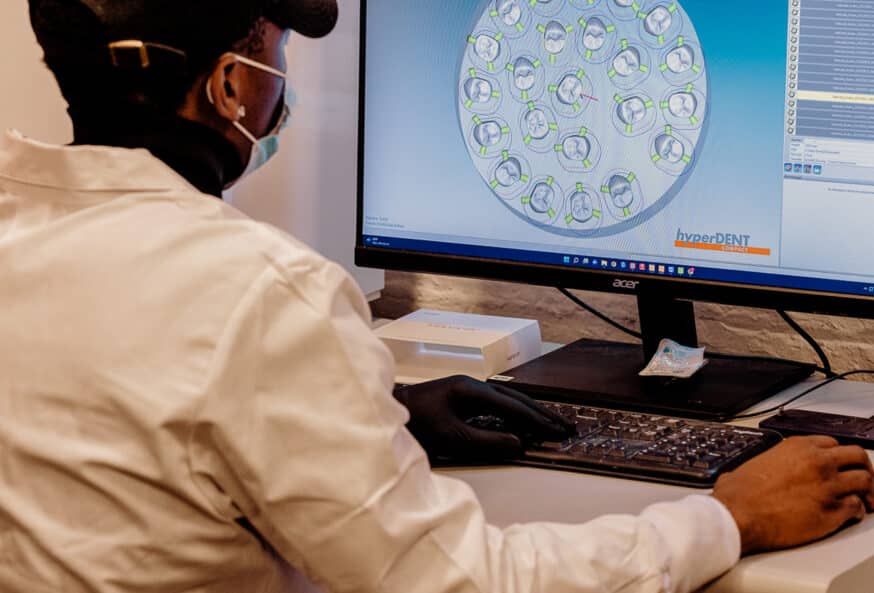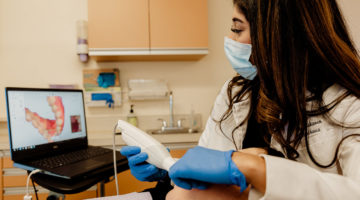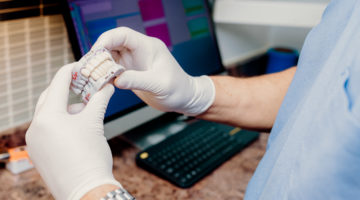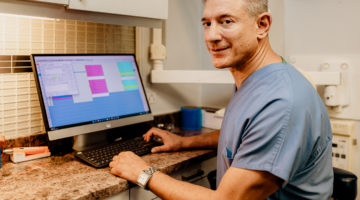One of the most dramatic transformations in the dental industry has been the embrace of modernized computer-aided design (CAD) and computer-aided manufacturing (CAM) dentistry.
Today, innovative dental offices can leverage these advancements in dentistry technologies to make the tooth restoration process more efficient, cost-effective, and accurate—all of which can lead to better patient experiences and outcomes.
Of course, dentistry is a field steeped in tradition and often resistant to change — especially radical transformation. This also leads to many dentists and other professionals taking a little while to learn about easier, better ways to go about things. As Dental Economics notes:
“The challenge of learning the technology was not so difficult. The bigger challenge was consistently implementing it to the point where it became the new, most frequently used behavior.”
But CAD/CAM dentistry is shaping up to be the real deal. This technology and its implementation is almost universally beneficial in a dental office, and can be applied to an array of reconstructive procedures, including inlays, onlays, veneers, dental crowns, and dentures. But what is CAD/CAM dentistry exactly, and how does it compare to traditional restorative dentistry? Let’s review.
What is the CAD/CAM workflow and how is it used in dentistry?
The adoption of digital workflows in dentistry is growing as more dentists learn the benefits CAD/CAM technology provides. Is it true that digital scanning is faster, more comfortable, and more precise? Let’s investigate the process of digital dental workflows and see.
Your workflow begins with an intraoral scan which is used to create a high-tech image and model. A dental laboratory like Dandy will then use this scan to either 3D print or mill a prosthetic or restoration. CAD/CAM workflows are replacing the classic impression mold and positive cast as the simplest, most precise way to model a patient’s mouth for the purpose of creating dental restorations
What is CAD/CAM technology used for?
CAD/CAM are digital technologies that utilize scanning, software, and 3D printing to digitally render, manipulate, and then fabricate an object.
These technologies are not unique to dentistry. Professionals from a variety of fields—ranging from interior designers to aerospace engineers—use one or both of these programs as a part of their daily workflows.
The reason for a CAD/CAM system’s popularity is simple. It enables experts to render more precise design representations and make virtual alterations on the fly. It has largely replaced manual design, drafting, and crafting, with quicker, more accurate, and higher quality processes.
What are the steps of the CAD/CAM process?
First, a dentist performs a digital scan. This can take as little as five-to-10 seconds. Compare to an analog impression, you’re already ahead of the old ways when it comes to speed and patient comfort.
Once your analog mold is ready, you can ship it to a lab to have a positive cast created. Or, if you use a digital dental process with intraoral scanners — you simply email or upload this scan to a lab like Dandy’s. Again, you are winning on speed and process simplicity, but you’re also saving shipping costs and potential mailing mishaps. (Did we mention that the digital scan is almost always more precise?)
Depending on the utility of your scans or impression, a lab will create a prosthesis, or replacement tooth (or teeth). If you are using a digital workflow, there’s a chance your prosthetics will be in the mail TO your practice in the same timeline it would take an analog impression to simply arrive at the same lab.
Once you receive a precision-made restoration, you’ll also find that dental workflow and adjustments are far less invasive and time-consuming when prosthetics are crafted with the precision of 3D imaging and CAD/CAM technology. Outside of initial setup cost, there is simply no procedural step where digital dentistry is not an improvement over long-established analog dental processes. If your conclusion is that CAD/CAM dentistry is better, you’re thinking like a modern dentist.
The Gradual Digitalization of Dentistry
Historically, CAD/CAM has been woefully underutilized within the dental industry. This is true for several reasons.
For one thing, dentistry is a field steeped in tradition and often resistant to change, especially radical transformation. For another, many dentists and other dental professionals just didn’t realize that there was a better, easier way to go about things. As Dental Economics notes:
“The challenge of learning the technology was not so difficult. The bigger challenge was consistently implementing it to the point where it became the new, most frequently used behavior.”
Compare the traditional denture workflow with a CAD/CAM digital denture workflow, for example:
Traditional Denture Process
The traditional denture process can be lengthy, typically taking 6–8 weeks to complete, with several patient appointments over that period. This includes:
- Preparing and taking preliminary manual dental impressions
- Preparing and taking definitive impressions
- Establishing a VDO
- Wax try-in
- Adjustment and delivery
During this process, there can be plenty of back and forth as the traditional impressions and models are shipped from the dentist’s office to the lab and vice versa, which increases the likelihood of an error occurring somewhere along the way. In addition, ensuring that the bite is accurate can require several different appointments for the patient’s fittings.
Dandy’s CAD/CAM Two-Appointment Denture Process
CAD/CAM tech has completely revolutionized the denture workflow. What used to take 50+ days and 6 or more appointments can now be done in 10 days with just two or three appointments.
For instance, with Dandy, the CAD/CAM dental process looks like this:
- Appointment 1 (Scanning) – The dentist performs an intraoral scan, which renders a perfect digital dental model that’s turned into a 3D image. That 3D image is then sent to the lab’s design team to check for proper spacing and alignment before printing.
- Appointment 2 (Fitting) – A week after the scan, the lab sends the final denture model. In the vast majority of cases, it will arrive as a perfect fit—but even if that’s not the case, it’s easy to make alterations.
The streamlining of the denture process can result in reduced patient time in the chair, easier planning and delivery of treatment, and less tedious manual work. Not to mention, patients receive a denture product that’s more precise and aesthetically pleasing. When it comes to the question of what can increase productivity in a dental office, CAD/CAM dentistry can certainly help out.
The Benefits of applying CAD/CAM to dentistry
Dentures aren’t the only dental process that a CAD/CAM system can optimize. At Dandy, we make the entire process digital—from start to finish. We apply it to several procedures, such as crowns, bridges, partials, nightguards, implants, and aligners.
Breaking the mold by going digital streamlines and simplifies traditional workflows. This, in turn, can create several tangible benefits for dental practices, including:
- Improved patient experience – Patients receive their orders in a fraction of the time. The dental products they receive are more accurate, longer lasting, and look better. They spend less time in the chair, and even when they’re in the chair, they don’t have to suffer unpleasant processes like taking traditional impression molds.
- Less chair time – When it comes to how to grow your orthodontic practice, fewer and quicker appointments mean that dentists can take on more clients and devote more of their time toward procedures that actually require their expertise. Both benefits can bolster your bottom line.
- Fewer remakes – The increased accuracy in scans and the reduced lab back and forth results in fewer errors and better end products. As a result, there’s a smaller likelihood that the dental product will need to be remade.
- Reduced overhead costs – A practice using this new dental technology may spend less money on materials and outsourcing costs. With Dandy, you also enjoy operational efficiency by eliminating the need to use multiple labs for fulfillment.
CAD/CAM software for digital dental restoration
Digital dental restoration is another new benefit of CAD/CAM technology. Basically, the days of handmade prosthetics, with all the instances and opportunities for human (and crafting) error have been improved upon. Computer-aided manufacturing is the process by which lab technicians actually design objects in the digital 3D space of a program.
In the instance of CAD/CAM dentistry, labs that use high-tech software are able to model restorations and craft for size, strength and fit — before ever modeling a prosthetic in the real world. This allows for a comparison of options and a focus on fit and comfort previously unavailable in analog lab work. In addition to crowns and bridges, software like Dandy’s can custom-mill abutments and posts, so that from scan to smile, you’re in control of every aspect of your patient’s restoration journey.
Adopt CAD/CAM tech with Dandy
CAD/CAM dentistry is shaking up the industry. By adopting this technology, a dental practice can completely modernize its traditional dental laboratory process and relationship.
Dandy is a fully digital dental lab—the first of its kind. Our platform was designed to overhaul every one of your dental workflows by digitizing the entire process, whether it’s orthodontics, zirconia crown prep, or dentures.
As a dental professional, if you’re looking for a forward-thinking partner who can transform your dental practice with CAD/CAM dental technology, get started with Dandy today and receive a free intraoral scanner.
Sources:
NIH. The Use of CAD/CAM in Dentistry. https://pubmed.ncbi.nlm.nih.gov/21726690/
Dental Economics. CAD/CAM technology. https://www.dentaleconomics.com/money/article/16393531/cadcam-technology



